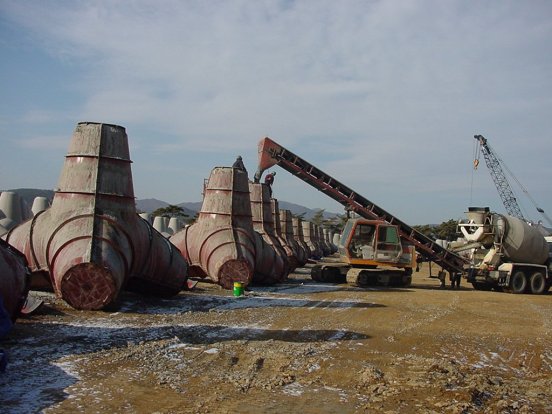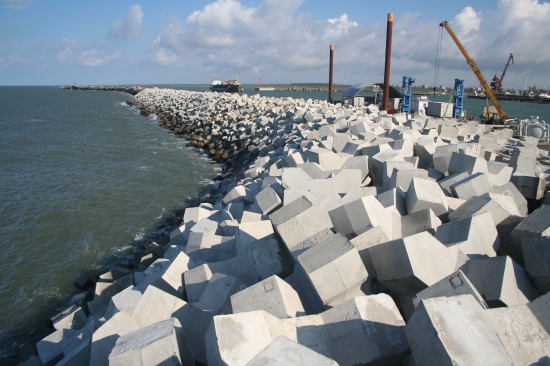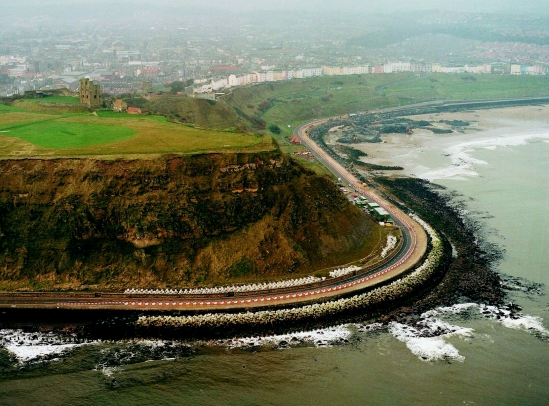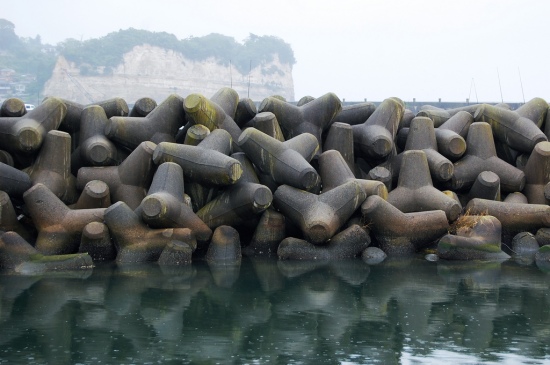[Tetrapods on the coast of Poland, source]
Engineered for coastal breakwater armoring and hard stabilization, tetrapods have proliferated along coastlines over the past 70 years. As an image search on Google or Flickr quickly demonstrates, there is a unique aesthetic pleasure in observing how piles of these concrete forms cohere, shift and collectively morph over time. Sort of like a manifestation of Plato’s dream of an anthropogenic pile of boulders, or very heavy industrial tinker toys; macro molecules performing at a mega-fauna gravity scale; the glue-like congealing of intricate forces of entropy; the design of deceleration.
[Tetrapods in Japan, source]
As mentioned earlier, Cabinet Magazine has a short interview with one of these hard-working Tetrapods (No. 16 – 2- 77) pictured in the photograph above (“Introduction to the Silence of the Dams“). The cognizant Tetrapod discusses its role in combating rising sea levels, and mentions that to date not a single tetrapod has ‘died’ or fallen apart due to erosion or cracking (concrete construction lasts approximately 70 years). Hypothetically, most manufactured tetrapods should still be where, or at least near to where they were initially placed.
The inhabitants of Japan have made their nation the site of a sublime corporate geomorphology experiment, as approximately half of the island’s coast line is covered with massive piles of Tetrapods. Most of the units are numbered and can be observed and tracked by satellite to monitor the efficacy of the overall effort.
 [Flow modeling source]
[Flow modeling source]
Similarly, computer modeling illustrates ever more complex diagrams of the dynamics of Tetrapods with fluid forces. But here the entropy equation is incomplete because the externalities – the open geographic system behind tetrapod manufacturing – are not factored in.
The Japanese Fudo Tetra Corporation produces the bulk of these tetrapods, owning the patent on the Tetrapod term. The company manufactures about 18 different tetrapod molds and exports pod designs to vulnerable, low-lying countries around the globe like Maldives, where one can find a monument to Fudo Tetra’s Tetrapods. However, speculation abounds as to whether all these tetrapods are really necessary, or if they are continually mass produced more out of economic desire rather than functional need. A bit turgid, but a coastal over-global stabilization? An unintended monument to a corporate ecology of excess?
 [source]
[source]
 [x bloc]
[x bloc]
As collective infrastructure, tetrapods seem to illustrate a broader meditation on concrete: the most called upon material in landscape, engineering and architecture. The tetrapod version of localized stabilization generates equal-to, and possibly greater-than counter disturbance in elsewhere landscapes – particularly in the altered voids of the limestone rock quarries from where the raw materials came, the sources of energy for that extraction and manufacturing (coal mining, off shore drilling, transportation logistics, etc.), which in turn leads to more climate change which, which in turn leads to more tetrapods in an accelerating repeating cycle.
Thus tetrapods are rendered simultaneously inadvertent geoengineering. The irony of this broader entropy equation is perhaps most efficiently expressed in the abstract calculations of embodied energy, or in more entertaining narrative, a previous post by Pruned.
 [source]
[source]
 [source]
[source]




what is the size of one tetrapod and what is the amount of concrete required for casting one tetrapod ,and what is the cost of one tetrapod or how many tetrapod are required for covering 400m area with height 6m
Tetrapod size and construction vary per manufacturer. There is a wide variety of shapes and sizes, so I think you would need a specification for a particular model to start to answer your questions.